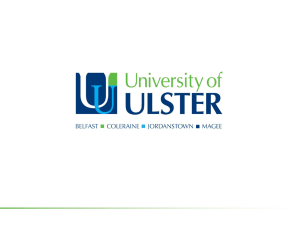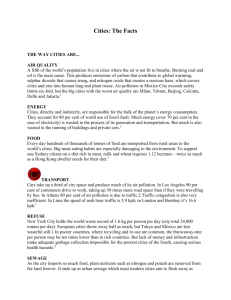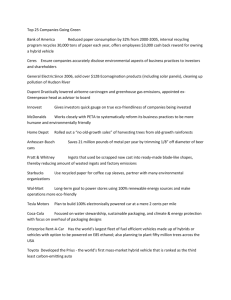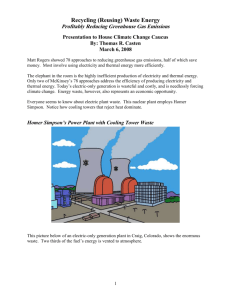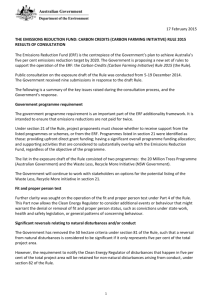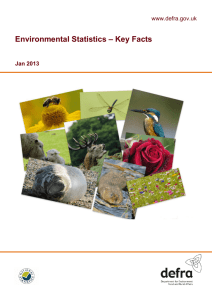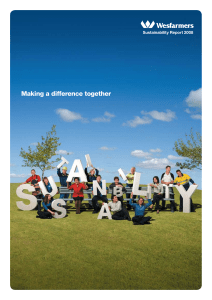Greenhouse gas emissions - Hobsons Bay City Council
advertisement
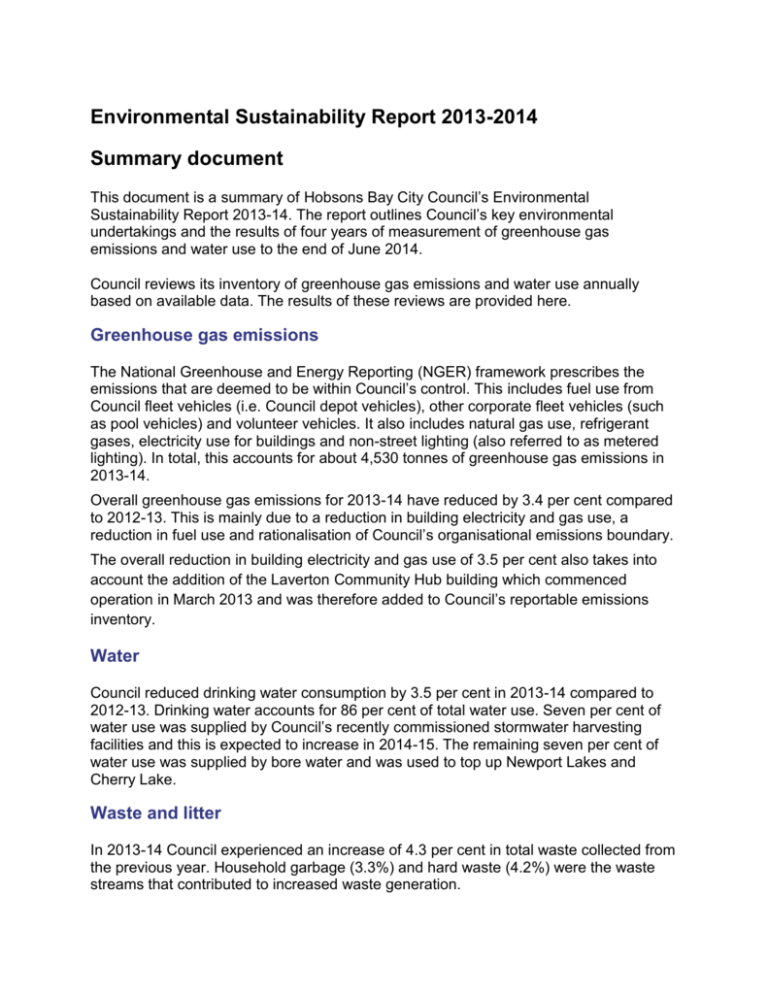
Environmental Sustainability Report 2013-2014 Summary document This document is a summary of Hobsons Bay City Council’s Environmental Sustainability Report 2013-14. The report outlines Council’s key environmental undertakings and the results of four years of measurement of greenhouse gas emissions and water use to the end of June 2014. Council reviews its inventory of greenhouse gas emissions and water use annually based on available data. The results of these reviews are provided here. Greenhouse gas emissions The National Greenhouse and Energy Reporting (NGER) framework prescribes the emissions that are deemed to be within Council’s control. This includes fuel use from Council fleet vehicles (i.e. Council depot vehicles), other corporate fleet vehicles (such as pool vehicles) and volunteer vehicles. It also includes natural gas use, refrigerant gases, electricity use for buildings and non-street lighting (also referred to as metered lighting). In total, this accounts for about 4,530 tonnes of greenhouse gas emissions in 2013-14. Overall greenhouse gas emissions for 2013-14 have reduced by 3.4 per cent compared to 2012-13. This is mainly due to a reduction in building electricity and gas use, a reduction in fuel use and rationalisation of Council’s organisational emissions boundary. The overall reduction in building electricity and gas use of 3.5 per cent also takes into account the addition of the Laverton Community Hub building which commenced operation in March 2013 and was therefore added to Council’s reportable emissions inventory. Water Council reduced drinking water consumption by 3.5 per cent in 2013-14 compared to 2012-13. Drinking water accounts for 86 per cent of total water use. Seven per cent of water use was supplied by Council’s recently commissioned stormwater harvesting facilities and this is expected to increase in 2014-15. The remaining seven per cent of water use was supplied by bore water and was used to top up Newport Lakes and Cherry Lake. Waste and litter In 2013-14 Council experienced an increase of 4.3 per cent in total waste collected from the previous year. Household garbage (3.3%) and hard waste (4.2%) were the waste streams that contributed to increased waste generation. There was an improvement in Council’s recycling rate over the previous year by 5.3 per cent. This is due to an increase in recycling through kerbside recycling (4.8%) and garden waste collection (6%). Factors that may have contributed to increased recycling include Victorian Government’s ‘Get it Right on Bin Night’ and ‘Back to Earth’ programs. Projects and activities Council also undertakes day-to-day activities and many projects to protect our biodiversity, manage waste, reduce our greenhouse gas emissions and manage water more wisely. These projects are outlined in this document. Some of these activities assist Council to meet its policy obligations for sustainability targets. Other activities assist the community to take action on sustainability or biodiversity aspects. Here are some of the achievements: Council’s Civic Centre building has seen a drop of 10.7 per cent in electricity and 3.5 per cent in gas. Electricity reduction can be attributed to installation of computer management software alongside improved maintenance using more efficient technology Council’s Altona library has seen a drop of 4.1 per cent in electricity. Electricity reduction can be attributed to a new heating and cooling system, a building management system and proactive staff behaviour in relation to energy usage Council has planted approximately 13,761 tube stock. The revegetation was completed by Council staff and as partnership plantings with a range of local volunteer/friends groups, school groups and various local industry and resident groups Council secured grants for on-ground conservation works to the value of about $108,000 the irrigation systems at Cyril Curtain Reserve, Paisley Park and Robertson Reserve were connected to the central control system. This software allows the irrigation system to be monitored and controlled remotely, and is designed to detect leaks and to shut down if a leak is detected Council conducted two ewaste recycling trials in September and November 2012. The trials attracted over 1,500 residents and recycling approximately 80 tonnes of ewaste Sustainability Victoria’s Detox your Home event was held at Council’s depot in Altona. A total of 146 people attended and 4.15 tonnes of brake fluid, detergents, cleaning products and herbicides were recycled My Smart Garden boasts 1,147 participating residents. The program delivered 15 events including a special workshop and follow-up planting day with members of the Karen community. An average of 26 people attended each workshop and rated the workshops highly numerous community events and programs were run throughout the year including o Karen healthy and sustainable living workshops o World Environment Day and Witness King Tides o Ambassadors for Sustainability program o Sustainability at home workshop series o National Tree Day o Friends group activities o Community Grants Program in total, 34 school events included activities with both hands-on environmental work such as planting and seed collecting and educational sessions
